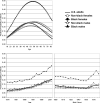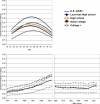Do birth cohorts matter? Age-period-cohort analyses of the obesity epidemic in the United States
- PMID: 19773107
- PMCID: PMC2782961
- DOI: 10.1016/j.socscimed.2009.08.040
Do birth cohorts matter? Age-period-cohort analyses of the obesity epidemic in the United States
Abstract
Many studies have cited the importance of secular changes or "period effects" as causes of the U.S. obesity epidemic. Unfortunately, relatively little attention has been devoted to the possible influence of cohort-related mechanisms. To address this current gap in the scientific literature, this investigation utilized the responses from 1.7 million participants in the 1976-2002 National Health Interview Surveys to determine how birth cohorts may have contributed to the rapid increase in the prevalence of obesity. Results from hierarchical age-period-cohort (HAPC) models confirmed that period effects are principally responsible for the U.S. obesity epidemic. However, HAPC models also demonstrated that birth cohort membership is influential. Independent of age and period effects, the predicted probability of obesity at age 25 increased by 30% for cohorts born between 1955 and 1975. Our results also showed that age, period and cohort effects varied by race/gender and educational attainment. For instance, increases in the predicted probabilities of obesity were particularly sharp for recent cohorts of Black females. Our investigation successfully demonstrated that both secular change and birth cohort membership have independently contributed to elevated odds of obesity among recent generations of Americans, suggesting that cohort-specific strategies may be needed to combat disconcertingly high rates of obesity in the U.S.
Figures





Comment in
-
Recent advances in age-period-cohort analysis. A commentary on Dregan and Armstrong, and on Reither, Hauser and Yang.Soc Sci Med. 2009 Nov;69(10):1449-51. doi: 10.1016/j.socscimed.2009.08.034. Epub 2009 Sep 18. Soc Sci Med. 2009. PMID: 19766371 No abstract available.
-
Don't birth cohorts matter? A commentary and simulation exercise on Reither, Hauser, and Yang's (2009) age-period-cohort study of obesity.Soc Sci Med. 2014 Jan;101:176-80. doi: 10.1016/j.socscimed.2013.09.004. Epub 2013 Sep 19. Soc Sci Med. 2014. PMID: 24094683
References
-
- Adams PF, Hendershot GE, Marano MA. Current Estimates From the National Health Interview Survey, 1996. National Center for Health Statistics; Hyattsville, MD: 1999. (Vital and health statistics, series 10: data from the National Health Interview Survey, no. 200). DHHS publication no. (PHS) 99-1528. GPO no. 017-01471-8. - PubMed
-
- Allman-Farinelli MA, Chey T, Bauman AE, Gill T, James WP. Age, period and birth cohort effects on prevalence of overweight and obesity in Australian adults from 1990 to 2000. European Journal of Clinical Nutrition. 2008;62(7):898–907. - PubMed
-
- Allman-Farinelli MA, Chey T, Merom D, Bowles H, Bauman AE. The effects of age, birth cohort and survey period on leisure-time physical activity by Australian adults: 1990-2005. British Journal of Nutrition. 2008;30:1–9. - PubMed
-
- Brownell KD. The Environment and Obesity. In: Fairburn Christopher G., Brownell Kelly D., editors. Eating Disorders and Obesity: A Comprehensive Handbook. 2nd ed. The Guilford Press; New York: 2002. pp. 433–438.
Publication types
MeSH terms
Grants and funding
LinkOut - more resources
Full Text Sources
Medical
Miscellaneous

